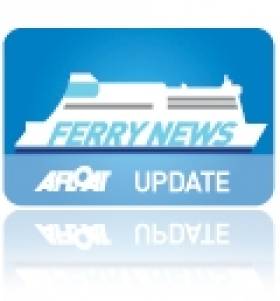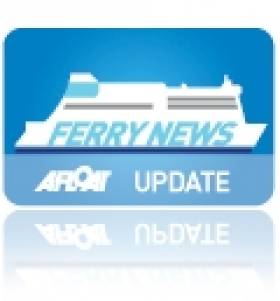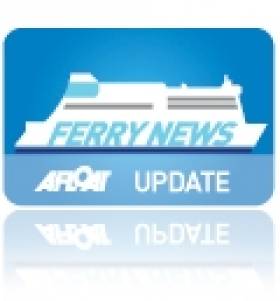Displaying items by tag: Superfast X Deployment
Stena Line Confirm ‘Superfast X’ Deployment to Dublin-Holyhead Service in Early 2015
#StenaSuperfastX – Amid much speculation the deployment of Stena Superfast X to Dublin-Holyhead route in early 2015 as previously reported on Afloat.ie has been finally confirmed by Stena Line.
The 29,800 tonnes ropax ferry will bring increased capacity as she will replace the route's existing smaller Stena Nordica which currently serves alongside Stena Adventurer.
Stena Superfast X is a sister ship of Stena Superfast VII and VIII that currently operate on the Irish Sea on the Belfast-Cairnryan route.
The introduction of Stena Superfast X as the new second ship on the Dublin-Holyhead service will see the vessel providing capacity for up to 1,200 passengers and almost 2 kms of lane space to accommodate a mix of car and freight traffic.
Ian Davies, Stena Line's Route Manager (Irish Sea South) said: "Providing additional capacity and facilities to expand our Dublin- Holyhead route is an important strategic development for Stena Line on the Irish Sea at this time. Our freight and travel customers will now be able to benefit from an enhanced service on this key trade and tourism gateway at a time when commercial and leisure traffic between Ireland and Britain are showing really encouraging signs of future growth.
Ian added: "By introducing a much larger ship onto the route, we are demonstrating our confidence and commitment to a trade and tourism gateway which will play a key part in helping to drive forward the economies on both sides of the Irish Sea. In the last 5 years alone Stena Line has invested over £250m across its Irish Sea operations and we are confident that the improving economic climate in Ireland and Britain will show that this significant resource commitment has been extremely well timed. As the major tourism gateway into Ireland it is important that Dublin benefits from the best possible transport links. We are looking forward to our enhanced passenger service into Dublin in 2015 playing its part in helping to drive up visitor numbers next year and in the years ahead."
Superfast X as previously reported is being fully modified by McGregor, who are converting the vessel to increase vehicle capacity understood to be closer to her original configuration before she takes up her position on the Dublin-Holyhead service.
The vessel will have a range of facilities including dedicated passenger and freight driver lounges, Barista Coffee House, Met Bar and Grill, a retail shopping outlet and other areas for passengers to relax and enjoy including a premium lounge.
Stena Line Deployment of ‘Superfast X’ Remains Tight Lipped
#StenaSuperfastX – Furthermore to a previous report over rumours that Stena Line are to deploy the Stena Superfast X onto the Dublin-Holyhead route in early 2015, following conversion work contracted to MacGregor, Afloat.ie has contacted the ferry company to comment, writes Jehan Ashmore.
MacGregor, part of Cargotec Corporation announced that they received a contract from Stena to convert the 29,800gt ropax ferry (currently named Dieppe Seaways) to optimise it for its new route between Dublin and Holyhead.
In response Peter Arvidsson Director Network & Fleet at Stena Line said "Although it is correct that MacGregor has been appointed by Stena RoRo to return the vessel to its original configuration, where the vessel will be deployed is currently a matter for ongoing discussion. From Stena Line's perspective it is possible that the Superfast X will be used within the Stena Line network or she may be chartered to a third party operator, but no decision has yet been taken".
It is understood that work is to begin once the charter of Dieppe Seaways running for DFDS Seaways Dover-Calais service ceases this month.
MacGregor's is to return the ro-pax ferry to its original configuration as dictated by expected requirements. This will involve the delivery of ro-ro cargo access equipment, including the design and installation of bow doors, a bow ramp, a new watertight door and a stern ramp.
Should the 'Superfast X' be introduced on the important Dublin-Holyhead route, she would provide an increase in passenger and freight capacity on the central corridor link. In addition she would be a closer match to the route's ro-pax Stena Adventurer, though not her running mate, the smaller Stena Nordica.
Stena Line's other Dublin Bay service from Dun Laoghaire to Holyhead has operated its fourth consecutive summer-only season which ended in early September. The route is served by the fuel thirsty and expensive to operate HSS Stena Explorer.
In efforts to stave off steep rise in fuel costs in recent years on the loss making route, Stena Line have reduced HSS sailings to a single daily round trip and increased crossings times from 99 minutes to 2 hours 20 minutes.
In response to Afloat.ie on the future of Dun Laoghaire-Holyhead route? Stena Line commented that the HSS is scheduled to return for the Christmas period (as previously reported) and is also scheduled for seasonal service 2015.
Stena Line to Take On Another ‘Superfast’
#StenaSuperfastX – According to Ships Monthly, Stena Line remain tight-lipped about the deployment of 29,800 tonnes ferry which is to join their fleet early in 2015.
Although an appearance on the Irish Sea service between Holyhead and Dublin has been rumoured for several months, neither Stena's head office in Gothenburg, nor Irish Sea management had made any announcement before the end of September.
MacGregor, part of Cargotec, say they have been contracted to provide a complete turnkey delivery of ro-ro cargo access equipment for the vessel, including the design and installation of bow doors, a bow ramp, a new watertight door and a stern ramp, and seem to be in no doubt that Stena Superfast X will be making an Irish Sea debut from Holyhead next January.
For more on this story click HERE.
Afloat.ie adds that should Stena Superfast X be introduced on the core Dublin-Holyhead central corridor route, she would be the third sister from an original quartet (built for Greek operator Superfast Ferries) to operate for Stena Line on the Irish Sea.
The existing Irish Sea 'Superfast' pair are Stena Superfast VII and VIII which operate Belfast-Cairnryan services having been introduced three years ago this month on a North Channel route. The route from Belfast to the Scottish port was switched from Stranrear to a new £80m port at Cairnryan.































































